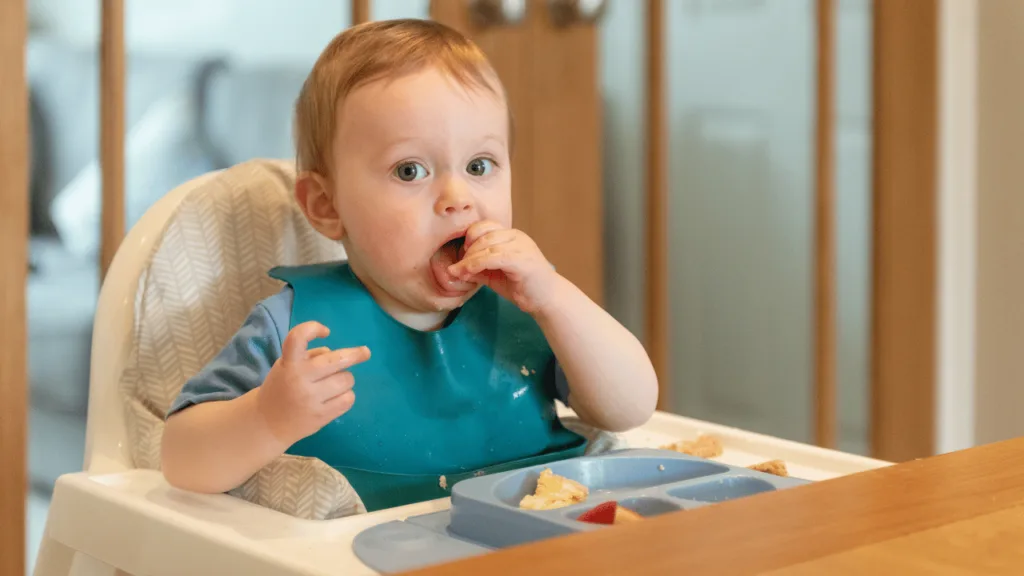
Ultimate Baby-led Weaning Guide for New Parents
Welcome to our comprehensive Baby-Led Weaning Guide! If you’re a new parent, you may be wondering about the best way to introduce solids to your little one. Baby-Led Weaning Guide is a popular approach that empowers babies to explore and feed themselves from the start. It involves offering soft, finger-sized pieces of food that your baby can pick up and eat independently. This method not only encourages independent eating but also promotes the development of fine motor skills and a wider variety of food exploration.
Starting solids with your baby is an exciting milestone, and baby-led weaning can be a safe and effective way to do so. It is recommended to begin baby-led weaning around 6 months of age when your baby shows signs of readiness, such as sitting up unsupported and showing interest in food. While breastmilk or formula will still be the main source of nutrition, offering a balanced diet with iron-rich foods, proteins, fats, fruits, and vegetables is essential for your baby’s growth and development.
Key Takeaways:
- Baby-Led Weaning Guide involves introducing solids to babies in a way that allows them to feed themselves from the start
- It promotes independent eating, fine motor skills development, and a wider variety of food exploration
- Start baby-led weaning around 6 months of age when your baby shows signs of readiness
- Offer a balanced diet with iron-rich foods, proteins, fats, fruits, and vegetables
- Baby-led weaning may cause some mess and gagging but is a safe and effective way to introduce solids
Benefits of Baby-led Weaning
Baby-led weaning has numerous benefits for both parents and babies. This method of introducing solid foods not only promotes the development of fine motor skills in infants but also encourages food exploration and may lead to less picky eaters in the future.
One of the key advantages of baby-led weaning is the promotion of fine motor skills. As babies are given the opportunity to pick up and feed themselves, they learn how to grasp and manipulate food, improving their hand-eye coordination and finger dexterity.
This approach also fosters food exploration, allowing babies to experience a wide range of flavors, textures, and colors. By offering a variety of age-appropriate foods, parents can introduce their little ones to new tastes and encourage a sense of curiosity and adventure when it comes to eating.
Benefits of Baby-led Weaning:
- Promotes fine motor skills development
- Encourages food exploration
- May lead to less picky eaters
In addition to promoting motor skills and food exploration, baby-led weaning can contribute to the development of a healthy relationship with food. By allowing babies to decide how much and what they eat, they learn self-regulation and develop a sense of autonomy when it comes to their meals.
Research has also indicated that babies introduced to solids through baby-led weaning have a reduced risk of obesity later in life. This method encourages babies to listen to their hunger and fullness cues, preventing overeating and promoting a balanced approach to mealtime.
Overall, the benefits of baby-led weaning extend beyond the immediate feeding process. It empowers babies to become active participants in their own nourishment, promotes fine motor skill development, fosters food exploration, and lays the groundwork for a healthy relationship with food in the long run.
Getting Started with Baby-led Weaning

Before embarking on the exciting journey of baby-led weaning, it’s essential to ensure that your little one is developmentally ready. Look out for these signs that indicate your baby is prepared:
- Sitting up unsupported
- Good head and neck control
- Loss of the tongue thrust reflex
- Reaching out and grabbing foods
- Chewing, even without teeth
Once you’ve observed these signs, you can start introducing solid foods slowly. Begin with one meal a day during a family mealtime when your baby is neither tired nor hungry. Offer soft, finger-sized pieces of food that your little one can easily pick up and feed themselves.
It’s crucial to provide a safe eating environment. Stay with your baby while they eat to ensure their safety and intervene if necessary. Offer a variety of foods from different food groups to ensure a balanced diet. Remember that in the beginning, babies may not consume much food as they are still primarily dependent on breastmilk or formula for nutrition. Be patient and allow your baby to take the lead in their feeding journey.
Remember, baby-led weaning is all about exploration and self-discovery. Enjoy watching your baby’s curiosity and growth as they explore new tastes and textures!
Introducing Solids to Baby
When introducing solids to your baby through baby-led weaning, it’s important to offer age-appropriate foods that are easy for them to handle. Here are some examples:
| Food | Preparation |
|---|---|
| Roasted sweet potato wedges | Cut sweet potatoes into wedge shapes and roast until soft. |
| Roasted apple slices with skin | Slice apples into thin rounds, leaving the skin intact, and roast until tender. |
| Roasted or steamed broccoli florets | Cook broccoli until it’s soft enough for your baby to chew. |
| Melon slices | Cut ripe melon into baby-friendly slices. |
| Avocado spears | Peel an avocado, cut it into long spears, and serve. |
| Soft meats like lamb or beef | Cook tender cuts of meat until they are easy to chew. |
Remember to always ensure that the food you offer is soft and in an appropriate shape for your baby to handle safely. Avoid foods that pose choking hazards, such as hard, sticky, or crunchy foods. Also, refrain from adding salt or sugar to your baby’s meals.
Introducing solids to your baby through baby-led weaning can be a messy but rewarding experience. It allows them to explore and develop a healthy relationship with food from an early age. Follow these guidelines, and remember to follow your baby’s cues and preferences as they take their first steps into the wonderful world of solid foods.
Best Foods for Baby-led Weaning
When it comes to baby-led weaning, choosing the right foods is key. It’s important to offer soft, finger-sized pieces that are easy for your baby to pick up and chew. Here are some of the best first foods for baby-led weaning:
- Roasted sweet potato wedges
- Roasted apple slices with skin
- Roasted or steamed broccoli florets
- Melon slices
- Avocado spears
- Soft meats like lamb or beef
These foods provide a variety of flavors, textures, and nutrients for your baby to explore. They are also easy to prepare and can be served as standalone options or combined creatively to introduce different taste combinations. The goal is to expose your baby to a wide range of nutritious foods to promote their palate development and future healthy eating habits.
Here’s a sample table of recommended first foods for baby-led weaning:
| Foods | Benefits |
|---|---|
| Roasted sweet potato wedges | Rich in beta-carotene and fiber for healthy growth and digestion |
| Roasted apple slices with skin | Packed with antioxidants and fiber to support immune function and gut health |
| Roasted or steamed broccoli florets | High in vitamin C, calcium, and iron for strong bones and immune system |
| Melon slices | Hydrating and loaded with vitamins A and C for optimal growth and development |
| Avocado spears | Healthy fats and essential nutrients for brain and heart health |
| Soft meats like lamb or beef | Excellent source of protein and iron for muscle and brain development |
Remember, while introducing solids to your baby through baby-led weaning, it’s essential to avoid foods that pose a choking hazard, such as hard, sticky, or crunchy foods. Also, steer clear of foods with added salt or sugar, as babies have sensitive taste buds and these can impact their developing preferences and health. Instead, focus on offering iron-rich foods to meet your baby’s nutritional needs as they transition to solid foods.
Safety Tips for Baby-led Weaning

When it comes to introducing solid foods to your baby through baby-led weaning, their safety is of utmost importance. By following these guidelines, you can ensure a safe and enjoyable feeding experience for your little one.
Preventing Choking during Baby-led Weaning
- Offer foods that can be easily squished between your fingers to avoid choking hazards.
- Avoid hard, raw, or crunchy foods that may be difficult for your baby to chew.
Safe Foods for Baby-led Weaning
It’s essential to choose safe foods that are appropriate for your baby’s age and development. Here are some examples:
| Foods | Description |
|---|---|
| Roasted sweet potato wedges | Soft and easy to chew, they provide important nutrients like vitamin A. |
| Roasted apple slices with skin | Soft and flavorful, they offer a variety of textures and tastes. |
| Roasted or steamed broccoli florets | Rich in vitamins and minerals, they can be easily grasped and chewed. |
| Melon slices | Refreshing and hydrating, they are perfect for introducing different flavors. |
| Avocado spears | Soft and creamy, they provide healthy fats and are easy to handle. |
| Soft meats like lamb or beef | Offer a good source of protein and can be cut into safe, manageable pieces. |
Other Safety Tips
- Stay with your baby while they are eating and never leave them unattended.
- Consider taking a first aid course to be prepared in case of choking emergencies.
- Introduce potentially allergenic foods one at a time and monitor your baby for any allergic reactions.
- Use a highchair that allows your baby to sit up straight and comfortably reach for food.
- Remember that baby-led weaning can be messy, so be prepared with bibs, a washable floor mat, and wipeable surfaces.
By following these safety tips and offering appropriate foods, you can confidently embark on your baby-led weaning journey while ensuring your baby’s well-being.
Conclusion
Baby-Led Weaning Guide is a wonderful approach to introducing solids to your baby, promoting their independence and development. By allowing your baby to explore and feed themselves, you are supporting the growth of their fine motor skills and encouraging a healthy relationship with food.
One of the key benefits of baby-led weaning is the opportunity for your baby to self-regulate and become less picky eaters. Giving them control over what and how much they eat helps them develop a diverse palate and can contribute to a lifetime of healthy eating habits.
When starting baby-led weaning, it’s important to ensure that your baby is developmentally ready and offer them soft, finger-sized foods that are easy for them to handle. Following safety guidelines and providing a balanced diet with iron-rich foods, proteins, fats, fruits, and vegetables are essential for their nutrition and well-being.
So embrace the mess, enjoy the journey, and watch your little one thrive as they explore the world of food through baby-led weaning. It’s an incredible experience that not only nourishes their bodies but also helps them develop a positive and lifelong relationship with food.
FAQ
What is Baby-Led Weaning Guide?
Baby-Led Weaning Guide is a method of introducing solid foods to babies that allows them to feed themselves from the start. It involves offering soft, finger-sized pieces of food that the baby can pick up and eat on their own.
What are the benefits of baby-led weaning?
Baby-led weaning promotes the development of fine motor skills, encourages food exploration, and may result in a less picky eater. It also helps babies develop a healthy relationship with food and lowers the risk of obesity later in life.
How do I know if my baby is ready for baby-led weaning?
Look for signs of readiness such as sitting up unsupported, good head and neck control, loss of the tongue thrust reflex, reaching out and grabbing foods, and chewing even without teeth.
What are some good first foods for baby-led weaning?
Some popular first foods for baby-led weaning include roasted sweet potato wedges, roasted apple slices with skin, roasted or steamed broccoli florets, melon slices, avocado spears, and soft meats like lamb or beef.
How can I ensure the safety of my baby during baby-led weaning?
To ensure safety, offer foods that can be easily squished between your fingers to avoid choking hazards, avoid hard or crunchy foods, stay with your baby while they eat, and follow safety guidelines. It is also important to introduce potentially allergenic foods one at a time and monitor your baby for any allergic reactions.











